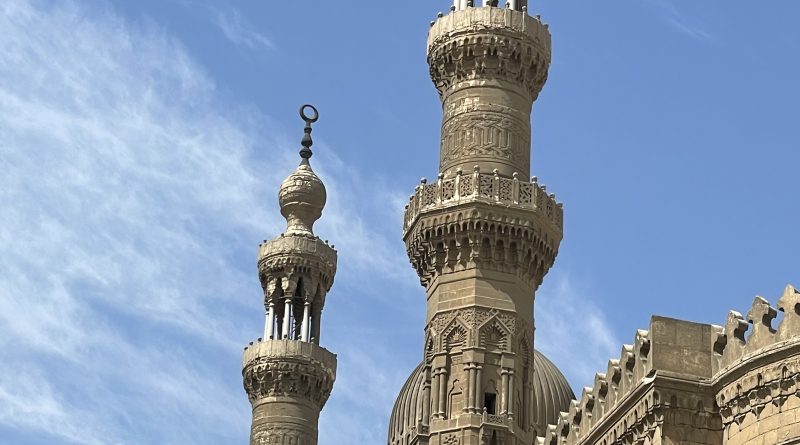A Tale of Cairo’s 1,000 Minarets
By: Nadra El-Beblawy, Mohamed El-Kashef, Mohamed Osman & Ayman El-Attar
Special to the Caravan
From Cairo’s first mosque in 642, to the Fatimid period, the Ayyubis, the Mamluks, the Ottomans’ and now contemporary Egypt, mosques and their minarets have changed throughout the country’s history and stand witness to its changing culture.
Cairo’s skyline has for centuries been dotted with hundreds of minarets and different-sized domes complemented by large open areas echoing the sounds of the azan, the call for prayer. Throughout the years, Cairo has been known as “the city of a thousand minarets,” for the innumerable sacred, tall structures spread across the capital.
Surrounded by such beautiful architectural goldmines, we often take this living history for granted, unmindful of their extraordinary exterior designs or how they stand witness to the city’s religious, cultural and political history. Dating back thousands of years, Amr Ibn Al Aas Mosque was built very differently from Al Fattah Al Alim, the newly constructed mosque of
the Administrative Capital and the latest addition to the 1,000 minarets. Between the period where both were built, other magnificently historical mosques were developed, reflecting the beauty of culture and religion. Over time, minarets of various mosques evolved into different shapes, sizes, and designs, depending on the eras they represented.
There were no minarets in the early days of Islam, but there was a need for a high spot where the prayer caller (muezzin) raised his voice to announce the hour of prayer. Instead, during the Prophet Muhammed’s time, Bilal Ibn Rabah would go to the mosque’s roof and call for prayer. Minarets emerged with the spread of Islam in Africa, Arabia and Asia. Egypt hosts several
ignificant minarets with different architectural designs. Mosques erected in the Arabian Peninsula and other regions that converted to Islam in the early days were distinguishable by their lack of minarets.
Minarets emerged during the Umayyad era in the Levant, in Damascus and other Muslim cities. The minarets were in towers with a square horizontal layout. Minarets of the Fatimid era were tall and nar- row, with an onion dome at the top, similar to the minaret of Cairo’s Al Hakim Al Akbar. The minarets of the Mamluk era were tall, but they did not have a defined foundation, and they were placed on balconies, like in the Sultan Hassan minarets. The first minaret that was built in Africa was that of Amr Ibn Al Aas’ mosque in Old Cairo, dating back to 642 AD.
The beauty of the architecture of the minaret attracts many visitors and is a landmarks of the old city. The twin minarets of Mohammed Ali’s Mosque, for instance, are among the main tourist attractions in Egypt. Different eras like the Fatimid, Mamluk and Ottoman period left unique minarets with different architectural designs. Throughout the 1,400 years of Islamic history in Egypt, the country witnessed various cultural and religious transformations with every era, going for instance from Sunni
to Shia under the Fatimids between 969 and 1171, and back to Sunni in 1171 under Salah Eldin El Ayoubi’s rule.
We take a stroll through the city’s religious and cultural transformations through the eyes of its most important minarets.
The mosque of Amr ibn al-As is located in Old Cairo, and is the first mosque ever built in Egypt and Africa, dating back to 642 AD. It was built under the caliphate of Omar ibn al-Khattab when Amr ibn al-As conquered Egypt, introducing Islam to the country. The mosque has undergone several renovations and was an important center of Islamic learning for 600 years. Its minarets were made at first from split palm tree trunks, stones and mud bricks, covered by a roof of wood and palm leaves.
The mosque of al-Hakim (al Hakim bi Amr Allah), built in 992, has one of the oldest minarets in Cairo. The mosque was named after the sixth Fatimid caliph of Egypt, who was also one of the most well-known Shia rulers of the period. It is well known for its wide and average height minarets. The mosque itself is designed with numerous arches and windows in the courtyard to provide for plenty of natural sunlight and an area for people to sit in peace.
Sultan Hassan was built in the period between 1356 and 1363 during the Mamluk era and is located in Salah al-Din Square in the capital. The Sultan Hassan is characterized by its massive sized minarets and its Mamluk style.
Regarded as major landmarks and tourist attractions in Cairo, the minarets of Muhammad Ali Mosque located in the Citadel are considered the most visible in the “city of a thousand minarets.” They were constructed between 1830 and 1848, following the Ottoman style as chosen by Muhammad Ali at that period.
Al-Hosary mosque located in the Sixth of October City is one of the modern mosques that was built in the last decade. It is the largest mosque in the city and is famous for the brilliance of its complex design with several unique minarets.
The Misr Mosque is under construction and is based in the Administrative Capital. The mosque is built in the Mamluk style and is
located on a plateau overlooking the whole city with an extraordinary minaret height of 140 meters, making it the highest minaret in Egypt. The mosque is also one of the largest mosques in the world with a capacity of 107,000 people.




